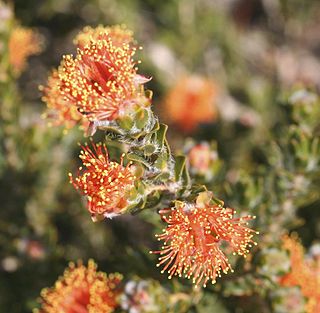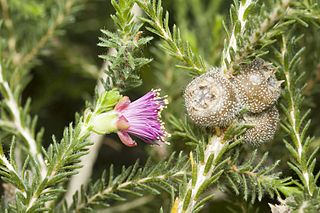
Melaleuca radula, commonly known as graceful honey-myrtle, is a plant in the myrtle family, Myrtaceae and is endemic to the south-west of Western Australia. It is an open, spreading shrub with narrow leaves, profuse pink or purple flowers in late winter and smooth, almost spherical fruits.

Eremaea is a genus of woody shrubs and small trees in the family Myrtaceae and is endemic to the south-west of Western Australia. Little study of the genus as a whole had been undertaken until Roger Hnatiuk researched Eremaea and published a paper in 1993, A revision of the genus Eremaea (Myrtaceae) in Nuytsia. The first species to be described was Eremaea pauciflora in 1837 and by 1964, the number of species known had increased to 12. Hnatiuk recognised 16 species, 5 subspecies and a number of varieties.

Eremaea pauciflora is a plant in the myrtle family, Myrtaceae and is endemic to the south-west of Western Australia. It is a shrub with small leaves and orange flowers at the ends of its branches. It has the most widespread distribution of the eremaeas with considerable variation in its characteristics so that three varieties are recognised. It was the first Eremaea to be described formally but was not originally given the name Eremaea.

Conothamnus is a genus of flowering plants in the family Myrtaceae and is endemic to the south-west of Western Australia. They are woody shrubs similar to melaleucas but differ in that their leaves are usually arranged in opposite pairs and the maximum number of seeds per fruit is three.

Eremaea fimbriata is a plant in the myrtle family, Myrtaceae and is endemic to the south-west of Western Australia. It is a small shrub with small leaves and single purple flowers on the ends of the branches. The fruits are woody, urn-shaped with a small opening at the top. Unlike other eremaeas which remain dormant during winter, Eremaea fimbriata begins the new year's growth in July or August.

Melaleuca parviceps, commonly known as rough honey-myrtle is a shrub in the myrtle family, Myrtaceae, and is endemic to the south-west of Western Australia. It is a shrub with varying shades of pink or purple flowers, the stamens tipped with yellow anthers. In describing it, John Lindley noted: "every twig ... is terminated by hemispherical heads of brilliant pink". It is similar to Melaleuca manglesii and Melaleuca seriata.

Eremaea beaufortioides is a plant in the myrtle family, Myrtaceae and is endemic to the south-west of Western Australia. It is a spreading shrub with oval to egg-shaped leaves, and orange flowers in spring. Flowers appear in groups of one to six on the ends of long branches formed in the previous year.

Eremaea purpurea is a plant in the myrtle family, Myrtaceae and is endemic to the south-west of Western Australia. It is a shrub with erect branches, small leaves and purple flowers in pairs on the ends of the branches. The fruits are woody, cup-shaped capsules which release their seeds when dry.

Beaufortia anisandra, commonly known as dark beaufortia, is a plant in the myrtle family Myrtaceae, and is endemic to the southwest of Western Australia. It is a densely branched shrub with egg-shaped, upward pointing leaves and which bears heads of dark bluish-purple to red flowers with stamen bundles of different lengths. It is reported to have an unpleasant odour.

Beaufortia bicolor, commonly known as Badgingarra beaufortia, is a plant in the myrtle family, Myrtaceae and is endemic to Southwest Australia. It is a densely branched shrub with rough, peeling bark, elliptical, upward pointing leaves and heads of red, orange and yellow flowers in November or December. It has been classified as a "poorly known" species.

Beaufortia bracteosa is a plant in the myrtle family, Myrtaceae and is endemic to the southwest of Western Australia. It is a shrub growing to a height of about 1 m (3 ft) with red to maroon flowers and woody fruit.

Beaufortia elegans, commonly known as elegant beaufortia, is a species of flowering plant in the myrtle family, Myrtaceae and is endemic to the southwest of Western Australia. It is an erect, diffuse shrub with crowded, curved leaves and heads of flowers that are usually reddish purple, although other colours also occur.

Beaufortia empetrifolia, commonly known as south coast beaufortia, is a plant in the myrtle family, Myrtaceae and is endemic to the southwest of Western Australia. It is a highly branched shrub with small, crowded leaves and pinkish to purple flowers in small, bottlebrush-like spikes in the warmer months. It is similar to Beaufortia micrantha except that its leaves are slightly larger.
Beaufortia eriocephala, commonly known as woolly bottlebrush or woolly beaufortia, is a species of flowering plant in the myrtle family, Myrtaceae and is endemic to the southwest of Western Australia. It differs from other beaufortias in having woolly red flowers and hairy younger leaves, with mature leaves that are less than 1 mm (0.04 in) wide.

Beaufortia incana, commonly known as grey-leaved beaufortia, is a plant in the myrtle family Myrtaceae, and is endemic to southwest of Western Australia. It is a shrub with crowded leaves that appear whitish due to their covering of fine, soft hairs on both surfaces. It has almost spherical heads of red flowers in spring.

Beaufortia macrostemon, commonly known as Darling Range beaufortia, is a plant in the myrtle family, Myrtaceae and is endemic to the southwest of Western Australia. It is a low shrub with multiple stems, hairy young leaves and three stamens in each stamen bundle.

Beaufortia micrantha, commonly known as small-leaved beaufortia or little bottlebrush, is a species of flowering plant in the myrtle family, Myrtaceae and is endemic to the southwest of Western Australia. It is a compact shrub with tiny leaves pressed against the stems and profuse heads of purple or pinkish-coloured flowers.

Beaufortia orbifolia, commonly known as Ravensthorpe bottlebrush, is a species of flowering plant in the myrtle family, Myrtaceae and is endemic to the southwest of Western Australia. It is an erect or spreading shrub with round, dished leaves crowded on the younger stems, and bright red flower spikes. It is found in laterite hills near Ravensthorpe. It is distinguished from other beaufortias by having green stamen bundles with the free ends red.

Beaufortia squarrosa, commonly known as sand bottlebrush, is a species of flowering plant in the myrtle family, Myrtaceae and is endemic to the southwest of Western Australia. The Noongar peoples know the plant as buno. It is sometimes a dense shrub, others straggling with 4 neat rows of small, oval leaves along the stems, and heads of red, orange or yellow flowers in the warmer months.
Beaufortia kwongkanicola, commonly known as Lesueur beaufortia, is a plant in the myrtle family, Myrtaceae and is endemic to the southwest of Western Australia. It is a shrub with crowded leaves and large, deep purple heads of flowers in late winter and spring and is found in the northern kwongkan.





















